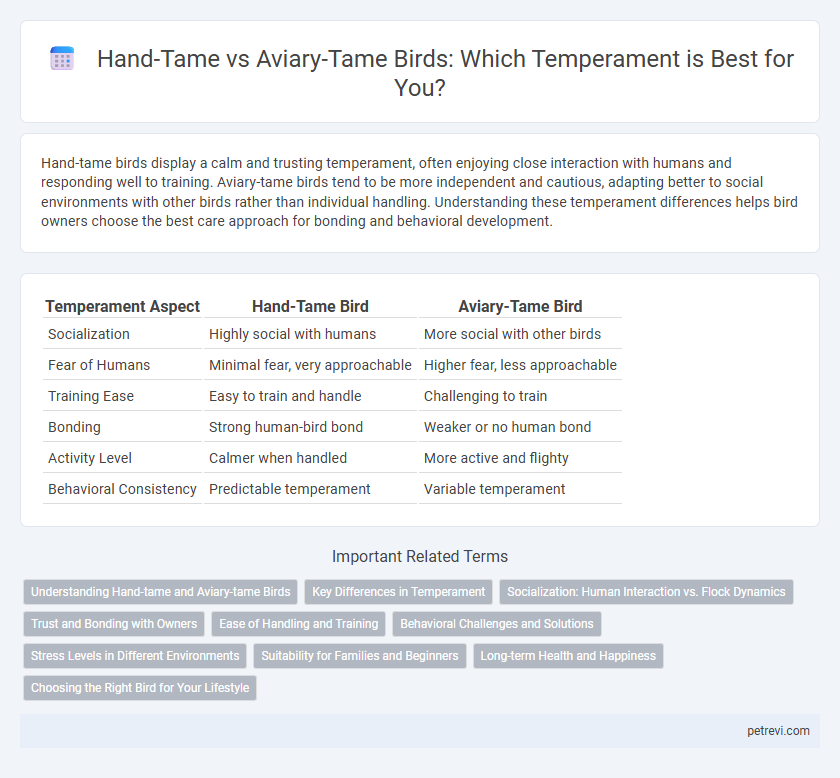Hand-tame birds display a calm and trusting temperament, often enjoying close interaction with humans and responding well to training. Aviary-tame birds tend to be more independent and cautious, adapting better to social environments with other birds rather than individual handling. Understanding these temperament differences helps bird owners choose the best care approach for bonding and behavioral development.
Table of Comparison
| Temperament Aspect | Hand-Tame Bird | Aviary-Tame Bird |
|---|---|---|
| Socialization | Highly social with humans | More social with other birds |
| Fear of Humans | Minimal fear, very approachable | Higher fear, less approachable |
| Training Ease | Easy to train and handle | Challenging to train |
| Bonding | Strong human-bird bond | Weaker or no human bond |
| Activity Level | Calmer when handled | More active and flighty |
| Behavioral Consistency | Predictable temperament | Variable temperament |
Understanding Hand-tame and Aviary-tame Birds
Hand-tame birds exhibit trust and comfort when handled directly by humans, often enjoying physical interaction and social bonding. Aviary-tame birds, while accustomed to human presence, maintain a cautious distance and are less likely to engage in direct contact. Understanding these distinctions aids in providing appropriate care and interaction strategies to enhance bird well-being and trust.
Key Differences in Temperament
Hand-tame birds exhibit close bonding with humans, displaying trust and reduced fear, making them more interactive and affectionate compared to aviary-tame birds. Aviary-tame birds remain wary of human contact, showing more independent and cautious behavior due to limited direct handling. Differences in temperament largely stem from the level of socialization and physical interaction experienced during early development stages.
Socialization: Human Interaction vs. Flock Dynamics
Hand-tame birds exhibit strong socialization specifically through frequent, positive human interaction, resulting in trust and responsiveness towards their owners. Aviary-tame birds develop social skills primarily via flock dynamics, relying on peer communication and hierarchical structures for stability and comfort. Understanding these differences is crucial for effective temperament management and ensuring optimal welfare in captive bird environments.
Trust and Bonding with Owners
Hand-tame birds exhibit a higher level of trust and bonding with owners due to regular direct interaction and gentle handling. Aviary-tame birds, while socialized within groups, often remain more cautious and less responsive to individual human attention. Building a strong emotional connection relies on consistent hand-taming practices that encourage familiarity and reduce fearfulness.
Ease of Handling and Training
Hand-tame birds exhibit greater ease of handling and faster learning in training sessions due to their close familiarity with human interaction and reduced fear responses. Aviary-tame birds, while socialized to flock environments, often require extended periods and consistent positive reinforcement for handling and training progress. Birds with hand-tame temperament typically display increased trust and responsiveness, facilitating smoother behavioral conditioning and cooperative care routines.
Behavioral Challenges and Solutions
Hand-tame birds exhibit stronger social bonds with humans but may develop behavioral challenges such as excessive vocalization and dependency, requiring consistent interaction and mental stimulation to mitigate stress. Aviary-tame birds tend to be more independent yet can display territorial aggression or fear responses, which can be managed through gradual socialization and environmental enrichment. Understanding these temperamental differences aids in applying targeted behavioral solutions to promote well-being and harmonious coexistence.
Stress Levels in Different Environments
Hand-tame birds exhibit lower stress levels in close human interaction environments due to their habituation to handling and social engagement. Aviary-tame birds, raised primarily in group settings with limited direct human contact, may experience heightened stress when abruptly introduced to individual handling or confined spaces. Understanding these temperament differences is crucial for optimizing bird welfare and minimizing stress-related behaviors across diverse care environments.
Suitability for Families and Beginners
Hand-tame birds exhibit strong bonds with humans, making them ideal companions for families and beginners seeking interactive pets, as they often display gentle and social behaviors. Aviary-tame birds, while generally less accustomed to individual handling, thrive in larger groups and provide a more natural environment, suitable for owners who prefer observation over direct interaction. Families and novice bird owners may find hand-tame species easier to manage and more rewarding due to their adaptable temperament and readiness for training.
Long-term Health and Happiness
Hand-tame birds often develop stronger bonds with their owners, resulting in enhanced mental stimulation and reduced stress, which directly contributes to improved long-term health and happiness. Aviary-tame birds benefit from natural socialization and flight opportunities, promoting physical fitness and behavioral enrichment essential for their overall well-being. Choosing the appropriate taming method tailored to a bird species' social needs and environmental preferences is crucial for sustaining optimal temperament and longevity.
Choosing the Right Bird for Your Lifestyle
Hand-tame birds display affectionate behavior toward humans and adapt well to regular handling, making them ideal for individuals seeking close interaction and companionship; popular species include parrots like Budgerigars and Cockatiels. Aviary-tame birds, accustomed to socializing primarily within their flock, require less direct human interaction and are better suited for owners who prefer observing birds in a more natural, less hands-on environment. Selecting the right bird temperament depends on lifestyle preferences, daily time availability, and the desired level of bonding, ensuring a harmonious relationship between owner and pet.
Hand-tame vs Aviary-tame for Bird temperament Infographic

 petrevi.com
petrevi.com